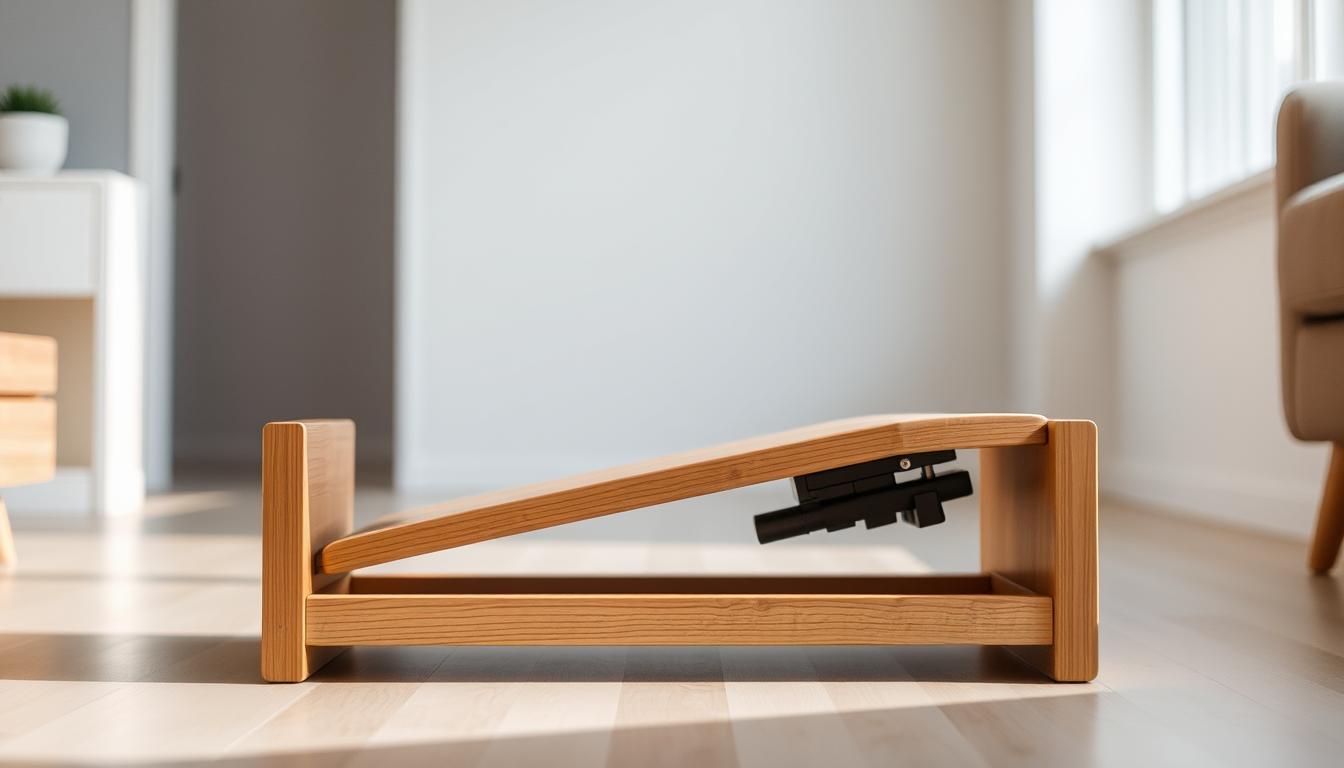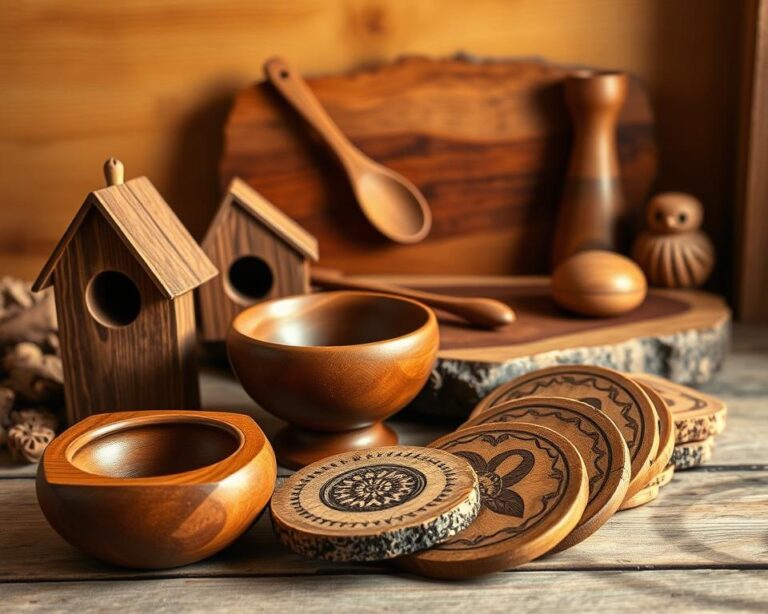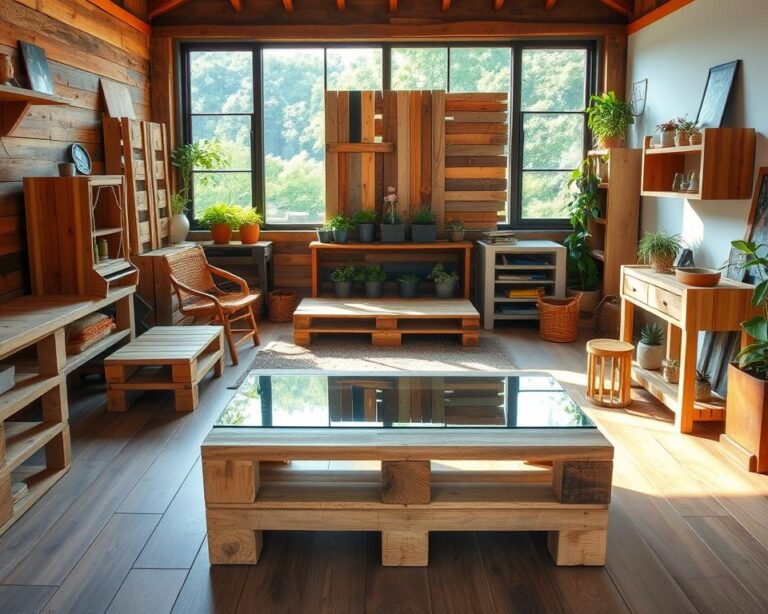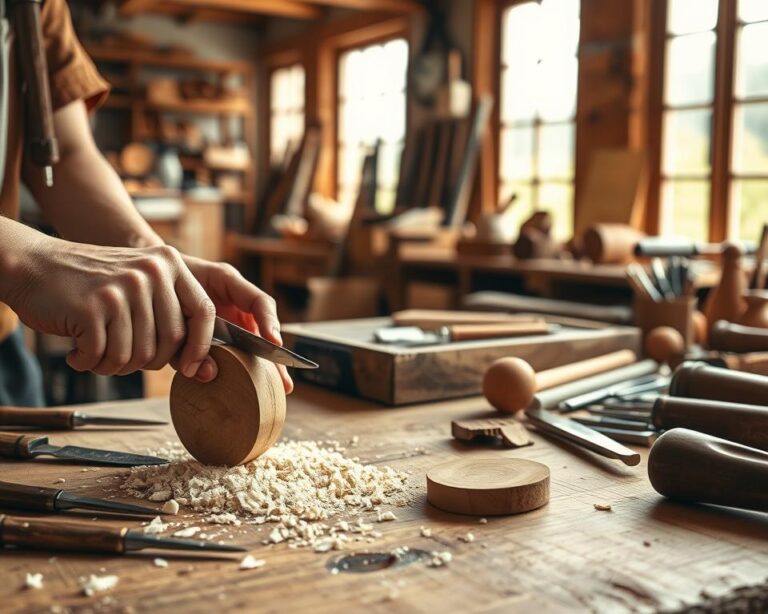Did you know more than 80% of office workers feel discomfort sitting? That’s why an adjustable footrest is key for a better work setting. Making your own can greatly improve how you sit and feel during those long workdays. This guide shows you how to craft one with an adjustable slope for perfect foot support.
With the right stuff, knowing your measurements, and figuring out the mechanics, you’ll tackle issues like swollen feet and legs. This can boost your health and work performance. Ready to make your workspace better? Let’s start!
Benefits of Using an Adjustable Footrest
An adjustable footrest can make your work life better in many ways. It is designed to make sitting at a desk more comfortable and healthier. These footrests let you change the angle, so you can find the position that feels best for you.
Improved Posture and Comfort
Using an adjustable footrest helps keep your feet, knees, and hips lined up right. By setting it at the ideal incline, you can avoid lower back strain. This leads to less stress on your body and a more comfy, productive time at your desk.
Enhanced Productivity
A footrest that adjusts can reduce discomfort and help you focus better. People often find they get more done. As pain decreases, concentration improves, making work more engaging.
Reduced Fatigue
Using a footrest regularly can greatly lower fatigue. It helps blood flow better by keeping legs in a good position, preventing cramps. This means you can work longer without being bothered by discomfort.
| Benefit | Description |
|---|---|
| Improved Posture | Promotes proper alignment of feet, knees, and hips. |
| Enhanced Comfort | Reduces strain in the lower back and legs. |
| Increased Productivity | Decreases discomfort while boosting focus and engagement. |
| Reduced Fatigue | Improves circulation and minimizes the risk of cramps. |
Materials Needed for the Project
Making an ergonomic footrest for your office chair means picking the right stuff. You want materials that last and feel comfortable. Here’s what you’ll need for your project.
Wood Types to Consider
Think about these woods for your footrest:
- Hardwoods: Oak and maple are strong and look good. They’re perfect for a solid base.
- Softwoods: Pine is light and easy to use, but not as sturdy as hardwoods.
- Plywood: It’s strong yet budget-friendly, great for dependable foot support with an adjustable angle.
Additional Tools Required
You’ll need these tools to make your footrest:
- Saw for cutting wood just right
- Drill for making holes for the adjustable parts
- Screws to put it all together
- Sandpaper to make it smooth
- Clamps and measuring tape for accurate work
Optional Finishes and Accessories
Add these for a better footrest:
- Non-toxic wood stains for beauty and protection
- Non-slip pads to keep it from moving
- Cushion or fabric for extra comfort
Step-by-Step Guide to Crafting Your Footrest
Making your own adjustable footrest for your desk can really boost your comfort while you work. This guide will show you how to create one. It’ll be adjustable for better posture support.
Measure and Cut the Base
First, figure out how tall and wide you want your footrest. You’ll want it high enough so your knees stay bent at 90 degrees. Then, cut your base wood to these specs. Make sure all edges are smooth to avoid splinters.
Create the Adjustable Mechanism
Simple levers or hinges work great for the adjustable part. They let the footrest move up or down and tilt to fit what’s comfortable for you. Make sure these parts move easily to daily use.
Assemble the Footrest
Now, put it all together. Secure the parts with screws or nails and make sure it’s stable. Try adjusting the tilt and height to make sure everything works right.
Designing the Footrest for Ergonomics
Creating an ergonomic footrest for office chairs involves important features for better comfort and support. It should be height-adjustable with an incline feature, catering to personal tastes.
Ideal Height and Angle Considerations
The footrest must allow changes in height from 4 to 6 inches to fit users well. A tilt of around 20 degrees can boost comfort and help blood flow, fighting tiredness.
Testing Out Different Designs
Trying out various shapes and designs is crucial. Doing so finds which is most comfy. Changes should make moving easy and provide strong support, focusing on ergonomic needs for office chair users. Comfort is key when looking into different designs.
Personalizing Your Footrest
Adding personal touches like color or extra padding makes your space more welcoming. By customizing, you improve both the look and function of your workspace. It turns the footrest into a perfect fit for you, enhancing its use.
| Design Feature | Ideal Range | Benefits |
|---|---|---|
| Height Adjustment | 4-6 inches | Allows for various user heights |
| Angle Tilt | 20 degrees | Improves comfort and circulation |
| Cushioning | Customizable | Enhances comfort during long sitting periods |
Adding the Adjustable Features
Making an adjustable footrest for your desk can make you more comfortable and productive. It’s important to choose the right adjustable parts. This will make sure the footrest works well and stays safe. We will show you various mechanisms, how to put them in, and keep them safe.
Types of Adjustable Mechanisms
Think about different mechanisms like hydraulic lifts or levers. These let you change the angle of the footrest to fit your needs. Picking a strong mechanism means it can hold your weight and adjust easily.
Installing the Adjustability Features
To install the features, you need to drill holes accurately. This makes sure everything fits right and doesn’t wobble. Good installation means your footrest will work smoothly.
Ensuring Stability and Safety
After putting it together, test the footrest to see if it’s stable. Putting rubber feet on it can stop it from slipping. This makes your workspace safer. Checking it regularly keeps it working right and safe.
| Type of Mechanism | Pros | Cons |
|---|---|---|
| Hydraulic Lift | Smooth height adjustment | May require maintenance |
| Lever-Controlled | Easy angle adjustment | Can be less durable |
| Manual Adjustment | Cost-effective | Requires physical effort |
Finishing Touches for Your Footrest
Polishing your footrest improves both its use and look. These last steps make sure it’s more than just comfy. It will also have a top-quality finish. Pay attention to important parts at this stage for the best outcome.
Sanding and Painting
Sanding your footrest is key. It gets rid of rough spots to protect your feet and preps the wood. Choose safe paint or stain to add strength and show off your style. An even coat makes it look and feel better, improving your experience with the footrest.
Upholstering for Added Comfort
Adding fabric or foam on top makes your footrest comfier. This layer gives soft support, easing foot pressure. Pick materials that match your office and learn to make a footrest that’s both comfy and stylish.
Checking for Sharp Edges
Check your footrest for sharp edges before using it. Sand down any rough spots to avoid discomfort or harm. It’s vital that your footrest is safe for ongoing use, along with being ergonomic. This care makes sure your footrest is safe and functional for your office.
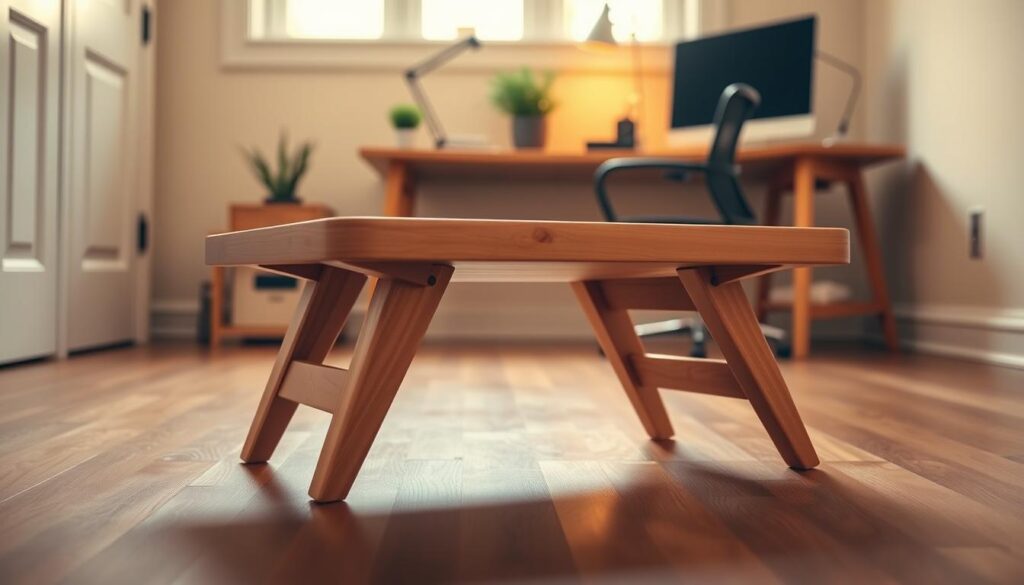
Maintenance Tips for Longevity
Keeping your adjustable footrest in top shape is key to its durability and performance. Regular care boosts comfort and extends its life. Here are easy ways to care for your foot support with an adjustable slope.
Regular Cleaning and Care
Clean your adjustable angle footrest often with a damp cloth. If it has upholstery, follow the cleaning instructions for the material. For wooden parts, use the right cleaners to avoid damage and keep it looking good.
Checking for Wear and Tear
It’s important to regularly check your footrest for any signs of wear or damage. Look for loose screws or issues with the adjustable mechanism. Fixing problems quickly keeps it safe to use and fully functional.
Adjusting the Mechanism as Needed
Your seating needs might change, so adjust your footrest’s height and angle when needed. This way, you can always enjoy its ergonomic benefits. It helps keep your posture right and reduces fatigue at your desk.
Common Mistakes to Avoid
To make an adjustable footrest work well, you need to focus on details. It’s important to avoid common mistakes to make it both functional and comfy. Here’s what to watch out for when making an adjustable footrest.
Skipping Measurements
Getting the measurements right is crucial. It ensures the footrest fits and works as it should for office chair users. Right sizes help with comfort and proper work posture all day.
Neglecting Ergonomic Considerations
Good design includes ergonomic principles. An adjustable footrest for desks should have the right height and tilt. Without this, it might cause discomfort or even harm over time.
Poor Quality Materials
The materials you pick determine your footrest’s strength and life. Choose high-quality stuff so it lasts and keeps being useful. Cheap materials will affect how well it works.
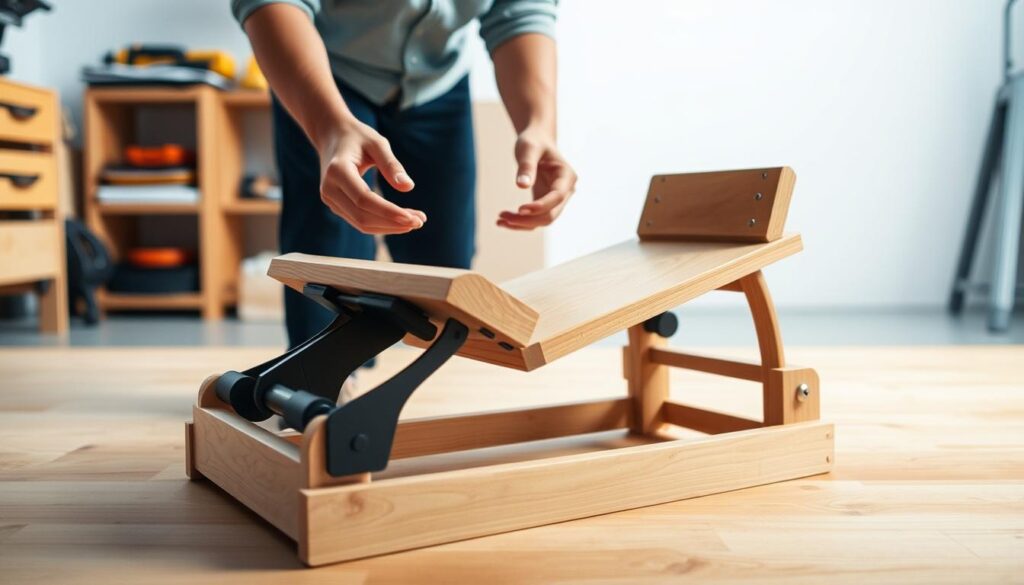
Alternatives to DIY Adjustable Footrests
Making your own adjustable footrest is rewarding. But, there are easier alternatives available. These alternatives offer ease and comfort without the DIY hassle.
Store-Bought Options
Many ergonomic stores sell ready-made adjustable footrests. These pre-made footrests have adjustable slopes to meet different needs. Buying a high-quality footrest saves time and works reliably.
Using Household Items
Sometimes, you can use what’s already in your home. Things like:
- Sturdy boxes
- Small pillows
- Books stacked to your desired height
These can quickly become foot supports. Just be sure they’re stable and comfortable.
Custom Solutions for Unique Needs
If you have special ergonomic needs, a custom footrest might be best. Experts can make one just for you. It will match your body and how you work, keeping you comfy all day.
Final Thoughts on Creating Your Footrest
As you finish making your adjustable footrest, take a moment to review your choices in design. Thinking about your decisions helps improve comfort and function. It also builds your skills for future projects. Pay attention to how an ergonomic footrest with adjustable incline makes your daily tasks more comfortable.
Feel free to add personal touches to your footrest. Try out various colors, textures, and additional features to make your footrest special. This customization meets your comfort needs better. It may also boost your productivity and happiness in your workspace.
Finally, think about sharing your experience with making the DIY footrest. Join community forums or ergonomic discussions to inspire others and learn from them. Talking about the hurdles and victories adds to everyone’s understanding of creating comfy workspaces for all.

